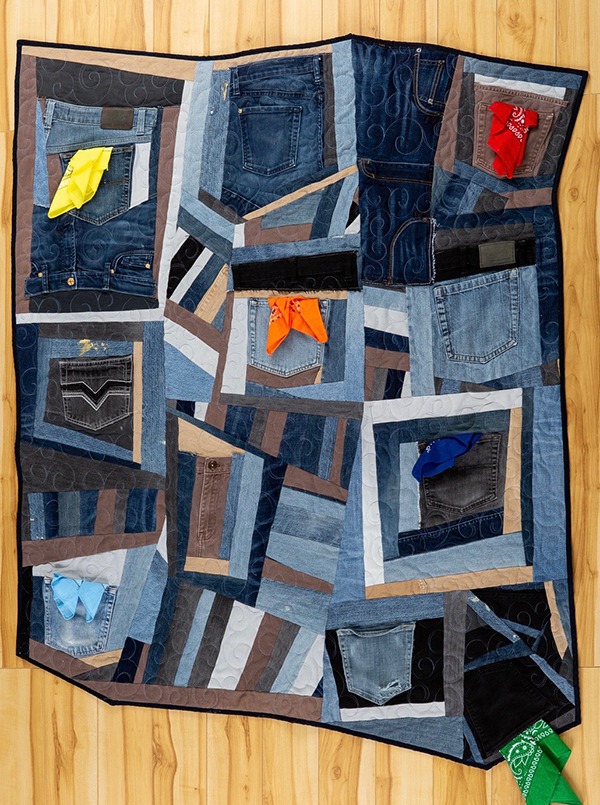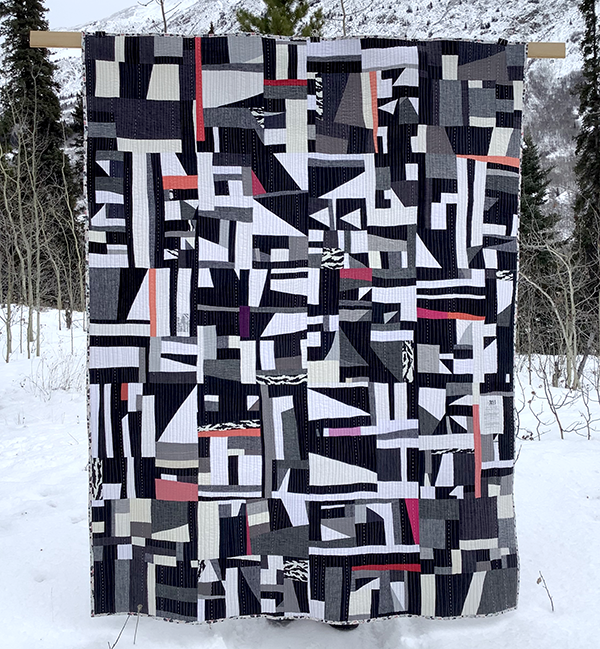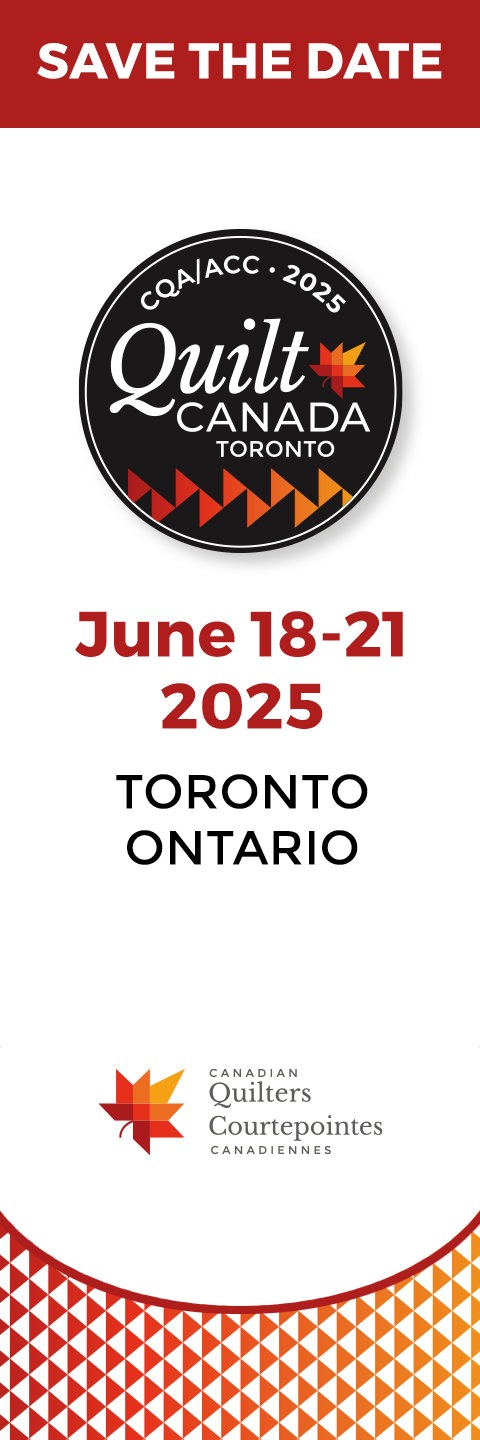In the third of a series of articles on sustainable quilting, Bridget O’Flaherty showcases some of the incredible efforts of those working towards positive change in the industry, and provides inspiration for quilters to do their part as well.
THE HARD TRUTH
For quilters and others who work with textiles, it’s troubling to learn that the production of the materials we love to use can have a negative environmental impact.
After decades of detrimental practices by high-impact industries, including the textile industry, the effects on the climate are evident for all of us to witness in real time, such as catastrophic floods and extreme weather events that are highly unusual. Many communities are suffering.
The effects are also impacting other habitats, with over 700 species in Canada currently at risk. Bees and Monarch butterflies, the Burrowing Owl, and the Whooping Crane are among the most threatened.
Fossil fuel use, water contamination, overproduction and over-consumption, waste mismanagement, and inefficient processes have fostered poor working conditions and social inequities along with environmental impacts. All industries globally contribute to this, and textiles (which includes quilting) are among the top 5%, with long production chains that tap into each of these.
This is the state of things viewed through one lens.
THE GOOD NEWS
The exciting thing is, there are thoughtful people doing amazing things to tip the balance and create a brighter future for the textile industry. When viewed through the lens of sustainability—which includes the balance of community, benefits, and materials—there are numerous companies, certification bodies, artists, and everyday quilters working towards positive change.
COMMUNITY
The quilting community is a generous one; it always has been. If you are thinking about your next quilt and have the ability to contribute to a community project, first of all—thank you. You can look to your local guild to help you find a meaningful project or you can consider one of several organizations. Here are just a few examples.
Victoria’s Quilts Canada is an amazing organization that provides cozy, handmade quilts to people in Canada who are fighting cancer. Quilts of Valour Canada provides quilts of comfort to members of the armed forces who have been wounded in the line of duty. Donating quilts to organizations like these, as well as local hospitals, etc., are a great way to use up your scraps and stash. I’m sure many of you have donated to causes like this in your own communities.
A relatively new organization is Quilts for Survivors. Vanessa Genier, an Indigenous mother from Missanabie First Nation in Ontario, has a passion for quilting and believes that a quilt is love sewn together, to bring people together. After learning about the mass graves that were found near residential schools in Canada, Vanessa embarked on a mission. She started a group on Facebook asking other quilters to join her in making quilt blocks to honour residential school survivors, and it’s still going strong today in the form of a not-for-profit organization.
QFS’s goal is to “honour the lives of the children who are just now finding their way home as Turtle Island releases the children back to their Nations across this land.” The group began a little less than two years ago. In that time they have delivered more than 3,000 quilts, and have a long waiting list to work towards.
This project is so powerful—the organization is acknowledging generational colonial trauma in such a loving way. People who are giving of their time, energy, materials, and funds are also getting an opportunity to experience the reciprocity of giving to this project, and to participate in reconciliation in a meaningful way. That right there is sustainability at its finest. We are looking at our past, working with our present for future generations.
BENEFITS
Quilting has many benefits, regardless of where we are on our creative journey. For some, it’s about the community; for others, the creativity; and often it’s a combination of both. Quilting can fill our cups when we need it most and patiently waits until we’re ready to dive in. There’s something special about knowing our fabric and machine are always ready to create when we are.
When our cups are full, we’re able to give back, through donation quilts or other meaningful projects. Quilting truly brings people together and serves a purpose beyond just the craft itself. Finding your people—a community that resonates with your values—can be a powerful source of support and inspiration, especially in challenging times. As we continue to navigate the challenges facing our planet, quilting can also serve as a way to promote sustainability and conscious consumerism. By making intentional choices about the materials and techniques we use, we can make a positive impact on both our own well-being and the health of the planet.
In the world of quilting, sharing is a fundamental aspect of the community, and it’s through this sharing that we reap many benefits. Quilt activists are driven to share their stories, which often touch on important social issues.

1971…When we couldn’t ask, by Bill Stearman: “It was a different time. I was 21. Same-sex relationships were newly legal in the bedroom. To ask someone if they were interested anywhere else, was not. The Hanky Code was invented to avoid police harassment, job loss, and public shame from names being posted in newspapers.”
One such activist is Bill Stearman (@bill_stearman), a modern quilt artist based in Prince Edward County, ON. With his expertly placed stitches, Bill expresses a range of emotions from joy to anguish, hope to gratitude, and love. His quilts offer a window into powerful and significant stories that resonate on both personal and societal levels, shedding light on issues that matter.
Award-winning quilt artist Sue Sherman (@sueshermanquilts), from Newmarket, ON, is on a mission to lend a voice to the animal kingdom. Using white cotton as her canvas, she meticulously paints and embroiders lifelike images with dyes and thread, a process that takes countless hours. Sue’s passion for protecting the earth’s creatures and their habitats is evident in her work. She hopes to inspire others to feel the same sense of urgency and take action to preserve the natural world. Through her unique art, Sue seeks to create a lasting impact on the planet and its inhabitants.
There are other ways that community and people are supported through quilting. When we choose fabrics or supplies that have considered sustainable practices, we are not only choosing materials that are better for the planet, but also for the people who are producing them.
Maiwa Natural Dyes is a great example of a company that goes to great lengths to support farmers, makers, and artisans to ensure they have sustainable futures. Maiwa supports several communities of block printers, embroiderers, weavers, and silk, organic cotton, and natural dye farmers. Their mission is to ensure sustainability by collaborating with the crafts in small-village, multi-generational, farm-based production, and local artisans. They are an internationally renowned company selling artisanal materials, clothing, and natural dyes. Maiwa generously shares knowledge with those who want to embark on a natural dyeing adventure through tutorials and workshops.
Is there a supplier you use that meets your needs in terms of sustainability? Please share your ideas by emailing them to bridget@bridgetoflaherty.com.
MATERIALS
When it comes to materials and their impacts on the environment, it’s a bit of a complex decision tree. How do we navigate to choose materials? What is our priority? Are we checking our stash before purchasing? Should we only up-cycle, use organic, or not shop at all? When we need new fabric, where do we go to buy trusted materials?
The answers to these questions are really personal; there is no one “right” answer. We know there is an issue with over-consumption and waste, so whatever you can do to shop your own stash, reuse, or upcycle will have an impact. But this is not always the right choice, so the options of buying new could include organic or other sustainable certifications whenever you can.
The good news is that there are more and more options available. The number of sustainable materials providers available today is far greater than even just a few short years ago. The future is bright!
Shopping locally is my first recommendation: local businesses and communities thrive when they are supported!
Simplifi Fabric, A Material Girl, Earth Indigo, and The Sustainable Quilter are all Canadian, online stores that focus on organic and eco products. This is an area that is growing, and you can help with that. The more we ask our local quilt stores to bring in certified products like those with the OEKO-TEX standard, the Global Organic Textile Standard (GOTS), or the Global Recycling Initiative (GRI), the more we will have available to us within our communities.

Linen Scrap Bin Project #3 by Sonya Oblak.
Anther great option is new-to-you fabrics. There are many stores popping up that re-sell fabric that has never been used. The Green Thimble, located in Edmonton, AB, has an online store that carries up-cycled, never-been-used materials, sewing machines, and tools (see Canadian Quilter summer 2023 issue, page 33). There are great options for dead-stock (off-cuts from the production process from textile designers, makers and manufacturing) with both Fabcycle and the not-for-profit organization Our Social Fabric (see Canadian Quilter summer 2022 issue, page 66). Both stores are located in Vancouver and have online shopping to connect across the country.
There are of course local reuse centres that often have materials and clothing that can be up-cycled and repurposed for sewing and quilting projects. There are amazing artists in our community that focus on and share with us their passion for sustainability. Sonya Oblak (@sonya.oblak) from Whitehorse, YT, and Melissa Marginet (@melissamarginet) from Beausejour, MB, are fantastic at sharing their process of up-cycling and repurposing materials in their incredible quilts.
It’s exciting to be part of the sustainability movement and see the changes that are coming. Even quilt shows are including sustainability as categories now. The National Juried Show at Quilt Canada is a leader in this, by introducing an Award of Excellence in Sustainability at the NJS this year in Halifax; soon followed by The Festival of Quilts in the United Kingdom. My hope is that sustainability will become normalized in the quilting industry, and we won’t need a specialized category or consider it a niche market.
Climate impacts are concerning, but it’s not all doom and gloom. There is a growing awareness of the need to change our ways. People are starting to realize the impact of their choices and are seeking out more sustainable options. There is a growing movement towards reducing waste, recycling materials, and using eco-friendly alternatives. In the textile industry, there are efforts to reduce the environmental impact of production, such as using organic cotton, reducing water usage, and minimizing waste. Quilters are making a difference by choosing a community, sustainable materials and techniques, using scraps and repurposed fabrics, and considering the environmental impact of their choices. By working together and making small changes, we can create a more sustainable future for ourselves, next generations, and the planet.
If you are interested in a comprehensive list of sustainable resources, sign up for Bridget’s newsletter and get a free download. www.bridgetoflaherty.com/join
If you are interested in joining The Green Stitcher’s Hive—a vibrant online community of eco-conscious quilters and textile enthusiasts who create with sustainability in mind, share knowledge, and inspire one another toward a brighter, more sustainable future—you can find the link on Bridget’s website. www.bridgetoflaherty.com
Bridget O’Flaherty is a Canadian free-motion embroiderer, quilter and textile artist, teacher, speaker and podcaster with a decade of experience in the sustainable building industry. Known as The Sustainable Quilter, she shares her passion for the natural environment in her art and online community.
bridgetoflaherty.com
bridgetoflaherty.com/threads-of-sustainability-podcast/
@thesustainablequilter


